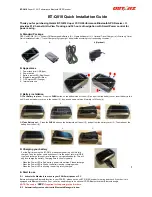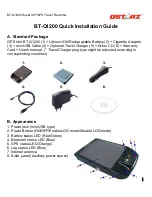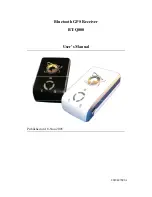
53
User Manual
exactly where to find the best possible replacement).
Three satellites are required for two-dimension positioning (which determines
position only) and four satellites are required for three-dimension positioning
(to determine position and elevation).
7.3.1 ACCURACY
In general, an SPS receiver can provide position information with an error of
less than 25 Meters and velocity information with an error of less than 5 Meters
per second. For applications that require much greater accuracy the effects of
SA and environmentally produced errors can be overcome by using a tech-
nique called Differential GPS (DGPS), which increases over-all accuracy.
7.3.2 WAAS
The Federal Aviation Administration (FAA), in cooperation with other DOT
organizations and DOD, is augmenting the GPS/SPS with a satellite-based Wide
Area Augmentation System (WAAS). WAAS will provide a signal-in-space to
WAAS compatible receivers to support en route through precision approach
navigation. After achieving initial operational capability, WAAS will be incre-
mentally improved to expand the area of coverage, increase the availability
of precision approaches, increase signal redundancy and reduce operational
restrictions.
7.3.3 DIFFERENTIAL GPS
Differential GPS (DGPS) uses a GPS receiver at a fixed point with a known
position of sub-meter accuracy. This is the control unit. The receiver collects
data for all visible satellites and computes predicted satellite ranges, which are
compared with actual ranges. The difference is the satellite range error, which
is converted to correction signals for use by a roving receiver.
It is assumed that this correction will be the same for other GPS receivers that
are in the same area and are using the same satellites for positioning. If the
correction is communicated to other receivers in the area (usually by a beacon
on the same site), the range error can be removed from satellite signals and
precise fixes calculated by these receivers.
It should be noted that not all data errors can be corrected in this way. Errors
that are caused by receiver noise (which is inherent in any GPS receiver) and
multipath problems cannot be eliminated with differential corrections.
(Multipath errors occur when the receiver’s antenna “sees” the reflections of
signals that have bounced off of surrounding objects.)
Using DGPS to eliminate the effects of correctable errors requires that the
user’s GPS receiver be connected to a compatible differential beacon receiver
and be within range of the broadcasting beacon. The differential beacon re-
Содержание EKP IV
Страница 1: ...User Manual Via Caboto 9 54036 Marina di Carrara MS ITALIA E mail info avmap it ...
Страница 4: ...6 User Manual ...
Страница 36: ...38 User Manual ...
Страница 40: ...42 User Manual ...
Страница 48: ...50 User Manual ...
Страница 58: ...60 User Manual ...
Страница 62: ...64 User Manual ...
Страница 70: ...72 User Manual Fig 10 6a Sample Calculation ...
















































